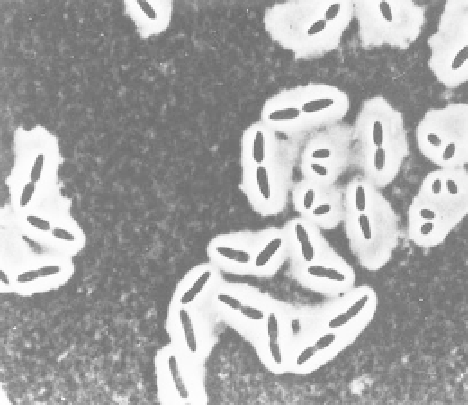Agriculture Reference
In-Depth Information
An example of soil bacteria,
Azotobacter
(White 1997).
Reproduced with permission
of Blackwell Science Ltd.
Figure 2.11
mm in length, such as protozoa). Within the microflora, we may distinguish two
broad groups based on their mode of nutrition: (1)
heterotrophs
, including many
species of bacteria and all the fungi, which require C in organic compounds as a
substrate for growth, and (2)
autotrophs
, including the remaining bacteria and
most algae, which synthesize cell components from the C of CO
2
. The energy
comes from sunlight (in the case of the photosynthetic bacteria and algae) or is
chemical energy derived from the oxidation of inorganic compounds. Microor-
ganisms differ in their requirement for molecular O
2
. Accordingly, they can be
aerobes,
which require O
2
as the terminal acceptor for electrons generated in res-
piration,
facultative anaerobes
, which normally use O
2
, but can adapt to oxygen-
free conditions by using NO
3
or other inorganic compounds as electron accep-
tors, and
obligate anaerobes
, which grow only in the absence of O
2
because O
2
is
toxic to them.
Bacteria and Actinomycetes
. Bacteria are small—as small as 1
m long and
0.2
m wide. They are round or rod-shaped and live in water films around soil
particles in all but the smallest pores (fig. 2.11). Under favorable conditions, bac-
teria multiply very rapidly so that their numbers in the soil can be enormous—
between 1 and 4
10
9
organisms/g. The main limitation to their growth is the
supply of substrate. Bacteria show almost limitless variety in their metabolism and
ability to decompose diverse substrates.
Actinomycetes are heterotrophs that form mycelial growths more delicate than
the fungi (see next paragraph). This group includes such genera as
Streptomyces
,
which produce antibiotics and can degrade resistant C compounds such as lignin.
Fungi
. The majority of fungi produce long filamentous hyphae, 1-10
m in
diameter, which may be segmented and/or branched. The network of hyphae,
called a mycelium, develops fruiting bodies on which the spores formed are often
highly colored. For example, members of the Basidiomycetes, or white-rot fungi,
and spore formers such as
Penicillium
and
Aspergillus
, are often conspicuous on
decaying wood and leaf litter in moist situations (fig. 2.12).
Some fungi are
soil inhabitants
. These fungi are predominantly saprophytes,
which means that they feed on dead organic matter in the soil. Fungi whose spores
are normally deposited in the soil, but which only germinate and grow when liv-
ing tissue of a suitable host plant is close by are called
soil invaders
. These fungi

